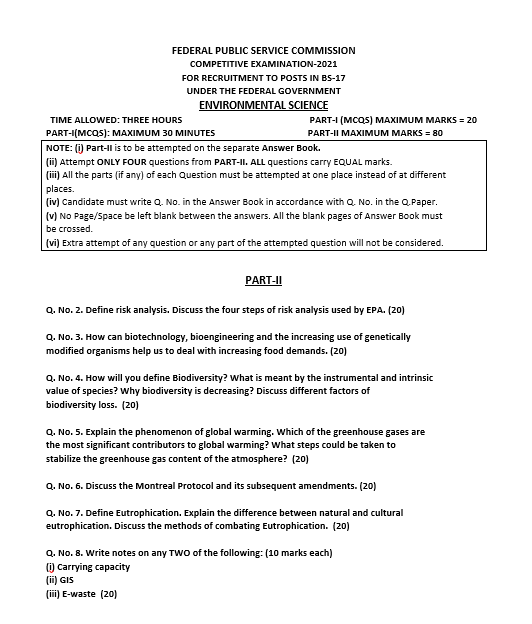Table of Contents
ToggleCSS Environmental Science Paper 2021
No. 2. Define risk analysis. Discuss the four steps of risk analysis used by EPA. (20)
No. 3. How can biotechnology, bioengineering, and the increasing use of genetically modified organisms help us to deal with increasing food demands? (20)
No. 4. How will you define Biodiversity? What is meant by the instrumental and intrinsic value of species? Why biodiversity is decreasing? Discuss different factors of biodiversity loss. (20)
No. 5. Explain the phenomenon of global warming. Which of the greenhouse gases are the most significant contributors to global warming? What steps could be taken to stabilize the greenhouse gas content of the atmosphere? (20)
No. 6. Discuss the Montreal Protocol and its subsequent amendments. (20)
No. 7. Define Eutrophication. Explain the difference between natural and cultural eutrophication. Discuss the methods of combating Eutrophication. (20)
No. 8. Write notes on any TWO of the following: (10 marks each)
- Carrying capacity
- GIS
- E-waste
Read Related Article
CSS Environmental Science Paper 2016
CSS Environmental Science Paper 2017
CSS Environmental Science Paper 2018
CSS Environmental Science Paper 2019
CSS Environmental Science Paper 2020
CSS Environmental Science Paper 2022
Environmental Sciences Past Paper 2023
Environmental Sciences Past Paper 2024
Summary of Questions
No. 2. Define risk analysis. Discuss the four steps of risk analysis used by EPA. (20)
Risk analysis involves identifying and assessing risks to determine how to manage them. The EPA follows four steps in risk analysis: 1) Risk assessment to understand hazards, 2) Risk management to decide on actions, 3) Risk communication to inform the public, and 4) Risk monitoring to track effectiveness. These steps help ensure safety and protect the environment.
No. 3. How can biotechnology, bioengineering, and the increasing use of genetically modified organisms help us to deal with increasing food demands? (20)
Biotechnology, bioengineering, and genetically modified organisms (GMOs) can boost food production by creating crops that are resistant to pests, diseases, and extreme weather. These technologies allow for higher yields, better nutrition, and less use of pesticides, helping to meet growing global food demands.
No. 4. How will you define Biodiversity? What is meant by the instrumental and intrinsic value of species? Why is biodiversity decreasing? Discuss different factors of biodiversity loss. (20)
Biodiversity refers to the variety of life on Earth, including different species, ecosystems, and genetic variations. Instrumental value relates to the practical benefits humans get from species, while intrinsic value is the inherent worth of species. Biodiversity is decreasing due to factors like habitat destruction, pollution, climate change, and overexploitation.
No. 5. Explain the phenomenon of global warming. Which of the greenhouse gases are the most significant contributors to global warming? What steps could be taken to stabilize the greenhouse gas content of the atmosphere? (20)
Global warming refers to the increase in Earth’s average temperature due to the buildup of greenhouse gases like carbon dioxide, methane, and nitrous oxide. These gases trap heat in the atmosphere, leading to climate changes. Reducing emissions, using renewable energy, and improving energy efficiency can help stabilize greenhouse gas levels.
No. 6. Discuss the Montreal Protocol and its subsequent amendments. (20)
The Montreal Protocol is an international treaty designed to protect the ozone layer by phasing out substances that deplete it, such as chlorofluorocarbons (CFCs). Amendments have been made to expand the treaty’s scope, including a focus on reducing hydrochlorofluorocarbons (HCFCs) and strengthening commitments by developed and developing countries.
No. 7. Define Eutrophication. Explain the difference between natural and cultural eutrophication. Discuss the methods of combating Eutrophication. (20)
Eutrophication is the process where water bodies become overly enriched with nutrients, leading to excessive plant growth and oxygen depletion. Natural eutrophication occurs over long periods, while cultural eutrophication is caused by human activities like pollution. Methods to combat eutrophication include reducing nutrient runoff, improving wastewater treatment, and restoring wetlands.
No. 8. Write notes on any TWO of the following: (10 marks each)
(i) Carrying capacity: Carrying capacity refers to the maximum population size that an environment can support sustainably. Exceeding this capacity can lead to resource depletion and environmental degradation.
(ii) GIS: Geographic Information Systems (GIS) are tools used to collect, manage, and analyze geographic data. They help in environmental planning, natural resource management, and disaster response.
(iii) E-waste: E-waste refers to discarded electronic devices. Improper disposal can lead to environmental contamination due to toxic materials like lead and mercury. Proper recycling and disposal methods are necessary to minimize its impact.
